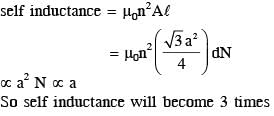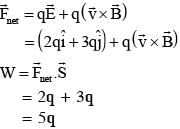JEE Main 2019 January 11 Shift 2 Paper & Solutions - JEE MCQ
30 Questions MCQ Test - JEE Main 2019 January 11 Shift 2 Paper & Solutions
A paramagnetic substance in the form of a cube with sides 1 cm has a magnetic dipole moment of 20 × 10–6 J/T when a magnetic intensity of 60 × 103 A/m is applied. Its magnetic susceptibility is :-
A particle of mass m is moving in a straight line with momentum p. Starting at time t = 0, a force F = kt acts in the same direction on the moving particle during time interval T so that its momentum changes from p to 3p. Here k is a constant. The value of T is :-
Seven capacitors, each of capacitance 2μF, are to be connected in a configuration to obtain an effective capacitance of (6/13) μF. Which of the combinations, shown in figures below, will achieve the desired value ?
An electric field of 1000 V/m is applied to an electric dipole at angle of 45°. The value of electric dipole moment is 10–29 C.m. What is the potential energy of the electric dipole?
A simple pendulum of length 1 m is oscillating with an angular frequency 10 rad/s. The support of the pendulum starts oscillating up and down with a small angular frequency of 1 rad/s and an amplitude of 10–2 m. The relative change in the angular frequency of the pendulum is best given by :-
Two rods A and B of identical dimensions are at temperature 30°C. If A is heated upto 180°C and B upto T°C, then the new lengths are the same. If the ratio of the coefficients of linear expansion of A and B is 4 : 3, then the value of T is :-
In a double-slit experiment, green light (5303 Å) falls on a double slit having a separation of 19.44 μm and a width of 4.05 μm. The number of bright fringes between the first and the second diffraction minima is :-
An amplitude modulated signal is plotted below :-

Which one of the following best describes the above signal?
In the circuit, the potential difference between A and B is :-

A 27 mW laser beam has a cross-sectional area of 10 mm2. The magnitude of the maximum electric field in this electromagnetic wave is given by [Given permittivity of space ∈0 = 9 × 10-12 SI units, Speed of light c = 3 × 108 m/s]:-
A pendulum is executing simple harmonic motion and its maximum kinetic energy is K1. If the length of the pendulum is doubled and it performs simple harmonic motion with the same amplitude as in the first case, its maximum kinetic energy is K2 Then :-
In a hydrogen like atom, when an electron jumps from the M - shell to the L - shell, the wavelength of emitted radiation is λ. If an electron jumps from N-shell to the L-shell, the wavelength of emitted radiation will be :-
If speed (V), acceleration (A) and force (F) are considered as fundamental units, the dimension of Young's modulus will be :-
A particle moves from the point  m, at t = 0, with an initial velocity
m, at t = 0, with an initial velocity  ms–1.It is acted upon by a constant force which produces a constant acceleration
ms–1.It is acted upon by a constant force which produces a constant acceleration  What is the distance of the particle from the origin at time 2s?
What is the distance of the particle from the origin at time 2s?
A monochromatic light is incident at a certain angle on an equilateral triangular prism and suffers minimum deviation. If the refractive index of the material of the prism is √3, then the angle of incidence is :-
A galvanometer having a resistance of 20 Ω and 30 divisions on both sides has figure of merit 0.005 ampere/division. The resistance that should be connected in series such that it can be used as a voltmeter upto 15 volt, is :-
The circuit shown below contains two ideal diodes, each with a forward resistance of 50Ω. If the battery voltage is 6 V, the current through the 100 Ω resistance (in Amperes) is :-
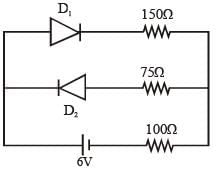
When 100 g of a liquid A at 100°C is added to 50 g of a liquid B at temperature 75°C, the temperature of the mixture becomes 90°C. The temperature of the mixture, if 100 g of liquid A at 100°C is added to 50 g of liquid B at 50°C, will be :-
The mass and the diameter of a planet are three times the respective values for the Earth. The period of oscillation of a simple pendulum on the Earth is 2s. The period of oscillation of the same pendulum on the planet would be :-
The region between y = 0 and y = d contains a magnetic field  A particle of mass m and charge q enters the region with a velocity
A particle of mass m and charge q enters the region with a velocity  the acceleration of the charged particle at the point of its emergence at the other side is :-
the acceleration of the charged particle at the point of its emergence at the other side is :-
A thermometer graduated according to a linear scale reads a value x0 when in contact with boiling water, and x0/3 when in contact with ice. What is the temperature of an object in 0 °C, if this thermometer in the contact with the object reads x0/2 ?
A string is wound around a hollow cylinder of mass 5 kg and radius 0.5 m. If the string is now pulled with a horizontal force of 40 N, and the cylinder is rolling without slipping on a horizontal surface (see figure), then the angular acceleration of the cylinder will be (Neglect the mass and thickness of the string) :-

In a process, temperature and volume of one mole of an ideal monoatomic gas are varied according to the relation VT = K, where K is a constant. In this process the temperature of the gas is incresed by ΔT. The amount of heat absorbed by gas is (R is gas constant) :
In a photoelectric experiment, the wavelength of the light incident on a metal is changed from 300 nm to 400 nm. The decrease in the stopping potential is close to :

A metal ball of mass 0.1 kg is heated upto 500°C and dropped into a vessel of heat capacity 800 JK-1 and containing 0.5 kg water. The initial temperature of water and vessel is 30°C. What is the approximate percentage increment in the temperature of the water ?
[Specific Heat Capacities of water and metal are, respectively, 4200 Jkg–1K–1 and 400 JKg–1K–1]
The magnitude of torque on a particle of mass 1kg is 2.5 Nm about the origin. If the force acting on it is 1 N, and the distance of the particle from the origin is 5m, the angle between the force and the position vector is (in radians) :-
In the experimental set up of metre bridge shown in the figure, the null point is obtained at a distance of 40 cm from A. If a 10Ω resistor is connected in series with R1, the null point shifts by 10 cm. The resistance that should be connected in parallel with (R1 + 10) Ω such that the null point shifts back to its initial position is
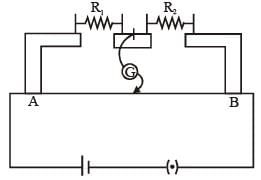
A circular disc D1 of mass M and radius R has two identical discs D2 and D3 of the same mass M and radius R attached rigidly at its opposite ends (see figure). The moment of inertia of the system about the axis OO', passing through the centre of D1, as shown in the figure, will be:-

A copper wire is wound on a wooden frame, whose shape is that of an equilateral triangle. If the linear dimension of each side of the frame is increased by a factor of 3, keeping the number of turns of the coil per unit length of the frame the same, then the self inductance of the coil :
A particle of mass m and charge q is in an electric and magnetic field given by

The charged particle is shifted from the origin to the point P(x = 1 ; y = 1) along a straight path. The magnitude of the total work done is :-





































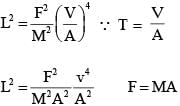


















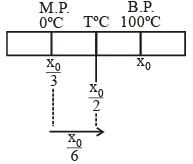






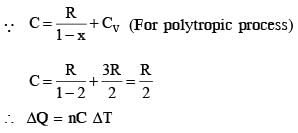

 ......(i)
......(i) ......(ii)
......(ii)



 .......(1)
.......(1)






